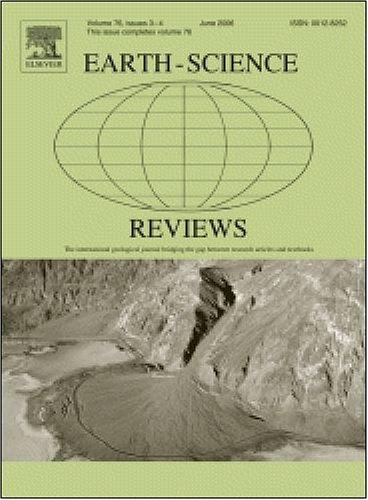Paleoclimatic significance of water isotopes in speleothem fluid inclusions
IF 10.8
1区 地球科学
Q1 GEOSCIENCES, MULTIDISCIPLINARY
引用次数: 0
Abstract
Speleothems (cave carbonate) contain fluid inclusions that are natural repositories of cave drip water and precipitation respectively. This water is stored within the speleothem calcite matrix and well preserved from post-depositional alterations in cave environments. Extracting the water and analysing its isotopes provide direct information about the hydrological cycle on timescales ranging from months to millions of years (>106 years). Therefore, speleothem fluid inclusions offer the opportunity to address key questions about paleorainfall and paleotemperatures, as water isotopes can be used to reconstruct temperatures or origin of moisture at the time of calcite deposition. This review aims to explore the background and history of speleothem fluid inclusion science and the development of analytical methods and records, thereby giving new insights into the potential of fluid inclusions. Based on a compilation of available speleothem fluid inclusion water isotopes, we developed a paleo-Global Meteoric Water Line (paleo-GMWL) that shows a similar slope to modern precipitation which corroborates the potential of fluid inclusions in the reconstruction of past precipitation. Similarly, first spatial observations seem to highlight the potential of fluid inclusions to contribute to a Global Network of Isotopes in Precipitation in the past (paleo-GNIP). Recent analytical developments will further enable the production of highly-resolved water isotope records for continental areas. Therefore, overall, there is a great potential in the use of speleothem fluid inclusions in paleoclimate sciences, which will provide information about past climate and allow data-model comparisons.
岩屑流体包裹体中水同位素的古气候意义
洞穴碳酸盐中含有流体包裹体,它们分别是洞穴滴水和降水的天然储存库。这些水储存在洞穴方解石基质中,保存完好,不受沉积后洞穴环境变化的影响。提取水并分析其同位素提供了从几个月到数百万年(106年)的时间尺度上的水文循环的直接信息。因此,由于水同位素可以用来重建方解石沉积时的温度或水分来源,因此,洞穴流体包裹体为解决古降雨和古温度的关键问题提供了机会。本文综述了岩浆岩流体包裹体科学的背景和历史,以及分析方法和记录的发展,以期对岩浆岩流体包裹体的潜力有新的认识。基于现有的岩石层流体包裹体水同位素的汇编,我们建立了古全球大气水线(古gmwl),该线显示出与现代降水相似的斜率,证实了流体包裹体在重建过去降水中的潜力。同样,第一次空间观测似乎突出了流体包裹体对过去降水同位素全球网络(古gnip)的贡献潜力。最近的分析发展将进一步使大陆地区高分辨率水同位素记录的产生成为可能。因此,总体而言,在古气候科学中使用洞穴流体包裹体具有很大的潜力,它将提供有关过去气候的信息并允许数据模型比较。
本文章由计算机程序翻译,如有差异,请以英文原文为准。
求助全文
约1分钟内获得全文
求助全文
来源期刊

Earth-Science Reviews
地学-地球科学综合
CiteScore
21.70
自引率
5.80%
发文量
294
审稿时长
15.1 weeks
期刊介绍:
Covering a much wider field than the usual specialist journals, Earth Science Reviews publishes review articles dealing with all aspects of Earth Sciences, and is an important vehicle for allowing readers to see their particular interest related to the Earth Sciences as a whole.
 求助内容:
求助内容: 应助结果提醒方式:
应助结果提醒方式:


